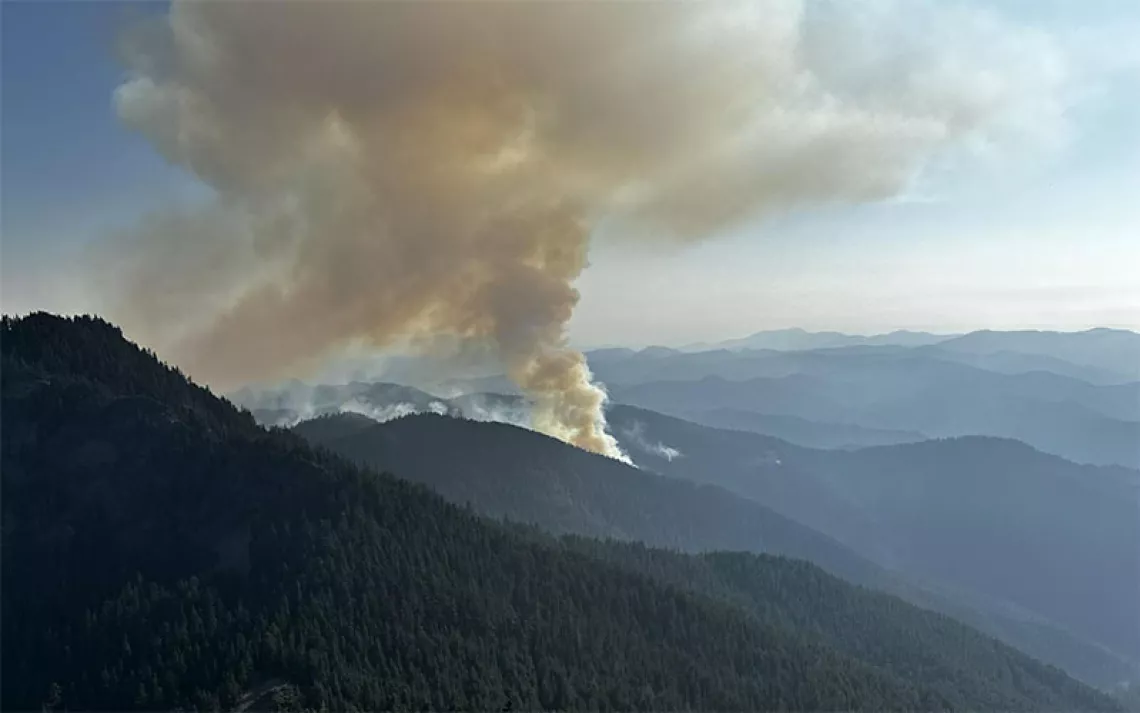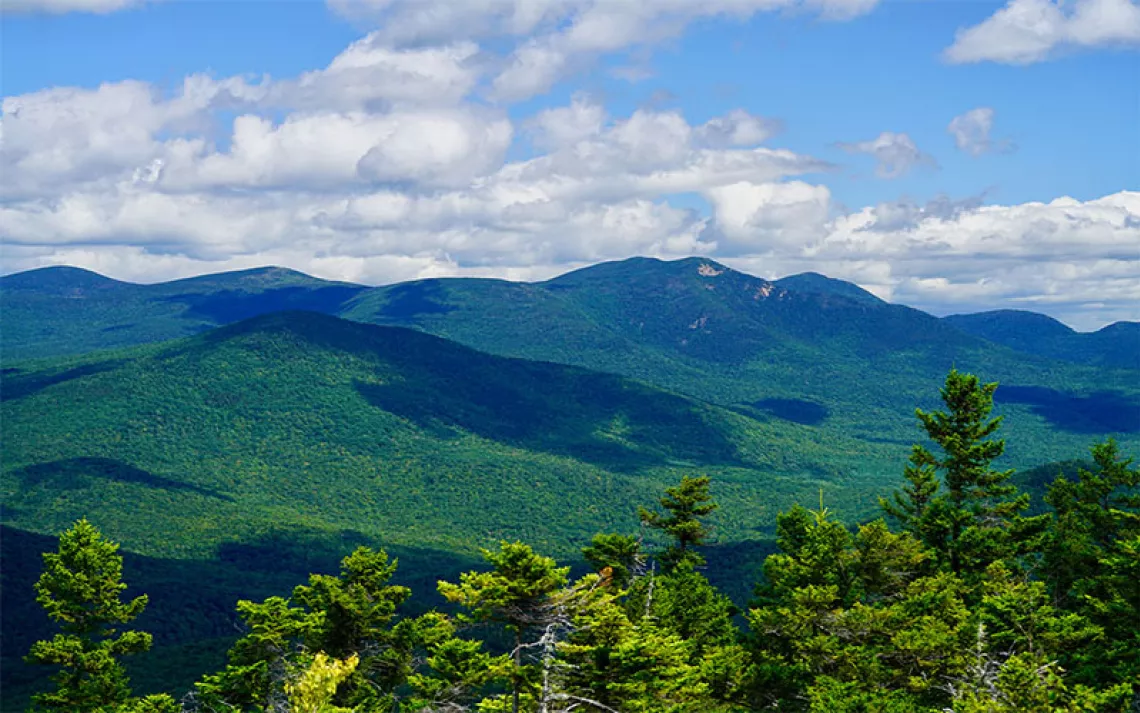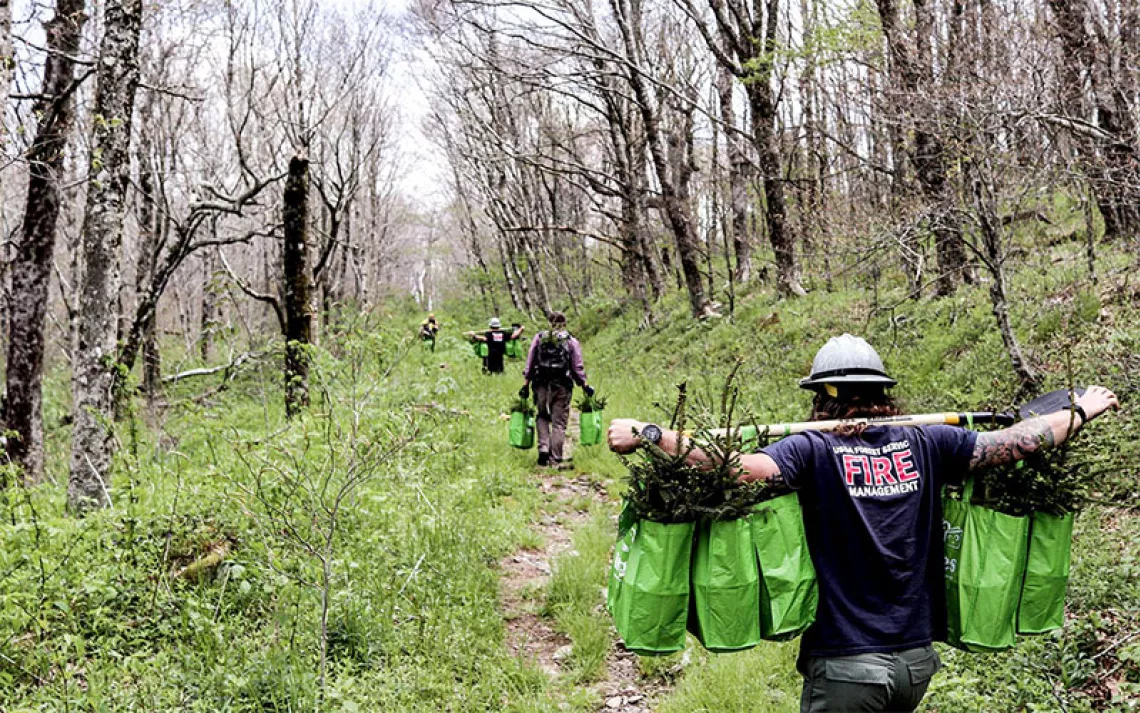The Northeast Has Unexpected Old-Growth Forests That Survived Colonial Axes
Expanding the remaining patches may hold the key to ecological resilience in the centuries to come
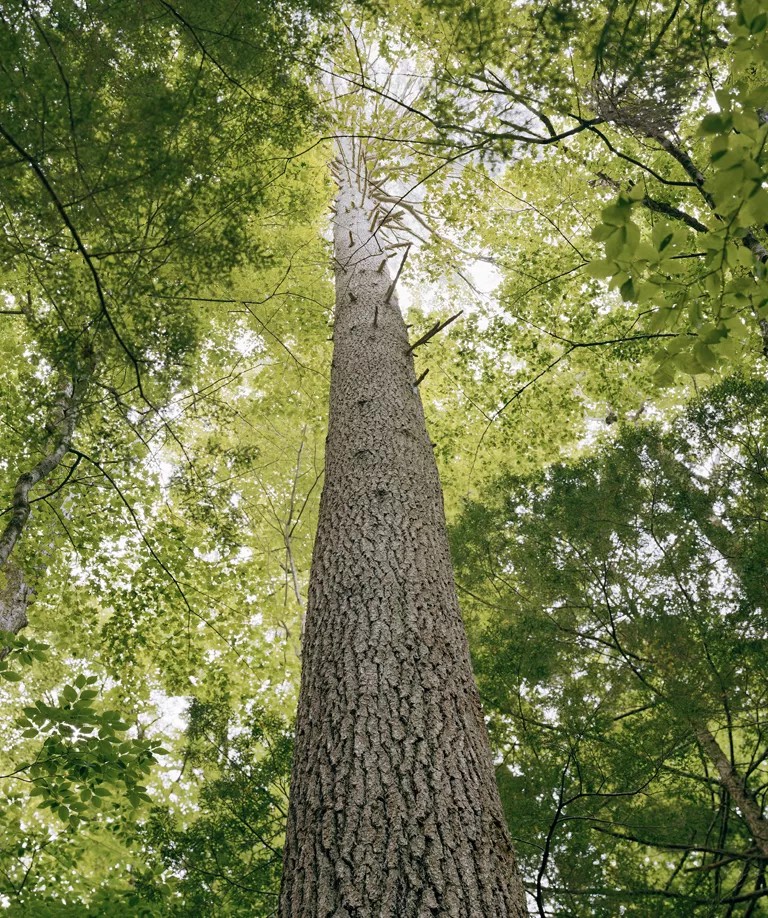
An eastern white pine in Mohawk Trail State Forest. | Photo by Mitch Epstein/Courtesy of Yancey Richardson Gallery
ON HIS MISSIONS TO FIND BIG TREES, Erik Danielson comes across humanity’ s detritus—often rusty cans and broken glass, the occasional old stone wall or chimney, and once a camp chair lodged in a tree miles from the nearest trail or road. But bushwhacking into the Adirondack Mountains of upstate New York on a humid summer morning in 2023, he found no signs that anyone else had been in these woods for a very long time.
At first, Danielson’s surroundings looked like any other forest in the northeastern United States—a tangle of underbrush and skinny trees fighting for the light, crowded by boulders and stumps. As he walked in deeper, though, the ecology shifted. The pines became larger, the moss thicker, and the forest harder to navigate because of downed trees and 20-foot cliffs. “It was really beautiful, but kind of hard terrain to get around,” Danielson recalled. He paused in a ravine framed by a waterfall, and then, climbing up the next ridge, he saw it: the eastern white pine he would eventually call Bigfoot. At 151 feet tall and more than 16 feet in circumference, it towered over the forest floor.
“It’s got this enormous footprint, and the trunk just goes up and up, and I think to myself, ‘This could be the largest white pine that I’ve ever seen,’” Danielson said. A self-taught botanist who never went to college and fell in love with trees while living in an off-grid cabin, he is now a laboratory technician in the Tree Ring Lab at Harvard Forest, the forestry department of Harvard University, and hunts for big trees in his spare time. Bigfoot—later confirmed to be the largest living member of its species by volume—was one of his largest finds yet.
More remarkable than Bigfoot itself was the fact that it was just one tree in a 550-acre tract of white pine forest that has likely stood since before the Civil War—an entire, intact old-growth forest hiding in one of the nation’s most densely populated and ecologically altered regions.
Before European colonization, such stands would have been commonplace. As the tallest trees in eastern North America, white pines were said to soar up to 230 feet in pre-colonial times, peppering the vast hardwood forests of the Northeast and Upper Midwest. A white pine sheltered leaders of the Haudenosaunee Confederacy as they drafted the Great Law of Peace, which united five tribal nations and later inspired the US Constitution. Tribal members still know the pine as the Tree of Peace.
To Europeans, however, white pines represented fuel for conquest. By the 18th century, Europe had few trees left that were tall enough to be fashioned into single-stick ship masts—a construction superior to fastening two shorter logs together—so colonists coveted the long, straight trunks of eastern white pines. In 1772, King George III decreed that any white pine more than 12 inches in diameter was his personal property, to be used for the Royal Navy. Enraged colonists in New Hampshire staged what later came to be known as the Pine Tree Riot.
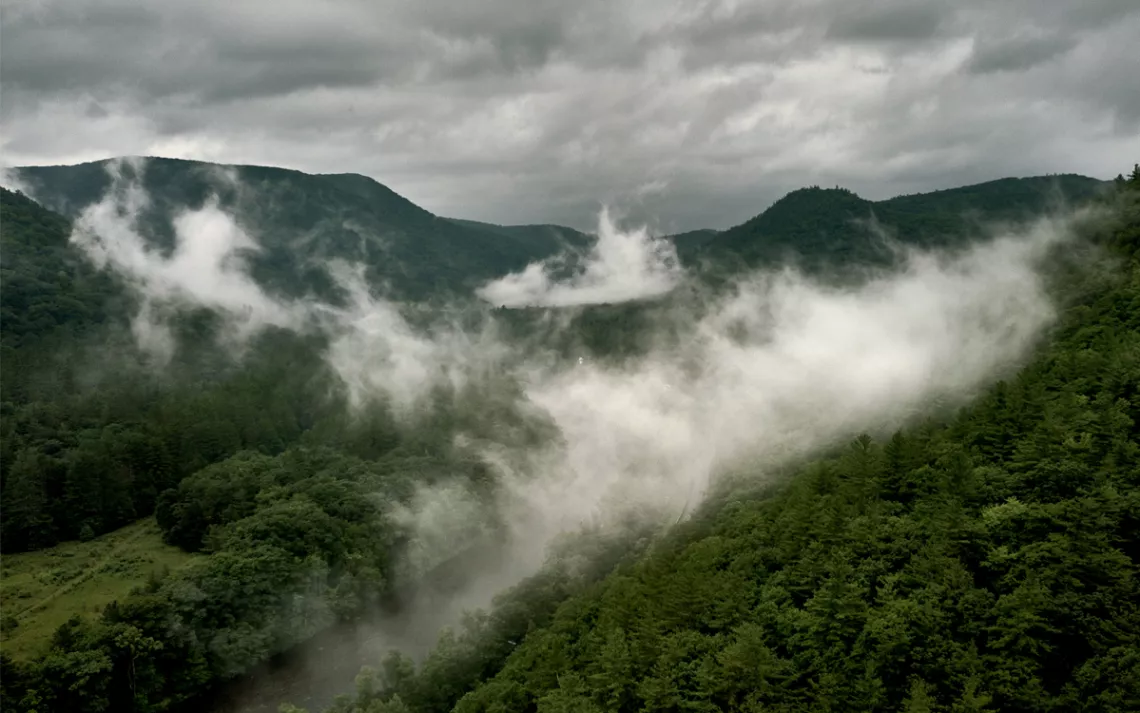
Western Massachusetts’s Mohawk Trail State Forest, which holds the majority of the state’s identified old-growth stands. | Photo by David Degner
Regardless of who “owned” them, white pines were one of the first species that settlers targeted, reducing stand after stand of them to stumps and slash. Once they had mostly exhausted the white pine supply, they moved on to other tree species. Between the 17th and 20th centuries, European settlers cleared more than 99 percent of the forests in New England and New York, not just once but two or even three times, first for agriculture and timber and then for industry.
Northeastern woods have a remarkable ability to grow back—today, roughly 80 percent of the region is again shaded by trees. But most modern forests are the kind of scraggly second or third growth that Danielson bushwhacked through to find Bigfoot: fairly uniform, with trees roughly the same size and age, and unnaturally young. Some estimates place the age of most northeastern forests at around 100 years old—mere teenagers by arboreal standards. Ecologists generally consider such forests unhealthy, susceptible to disease and lacking in the complexity that makes old-growth forest so ecologically rich. For generations, most people assumed that old growth simply no longer existed in this part of the world.
“In the old days when old growth was brought up, people thought of the Pacific Northwest,” said Bob Leverett, a former engineer who identified new areas of old-growth forest in Massachusetts. “A lot of people said, ‘Old growth in Massachusetts?’”
In the 1980s, Leverett and others began documenting remnants of forest in Massachusetts and beyond that had somehow escaped colonists’ axes. The trees weren’t as big as you might expect; cold New England winters and regular wind and ice storms prevent trees from reaching the proportions of the West Coast’s famous evergreens. But like all old-growth forests, those in the Northeast have evolved through cycles of natural disasters and regrowth. That differentiates them from forests that have been intensively logged or otherwise managed by people. They have richer soil and a higher diversity of both plants and animals, they store more carbon, and they’re more resilient in the face of disease and climate change. They serve as a natural laboratory for studying how forest ecosystems function without human interference. And perhaps just as important, they are places that spark awe and wonder.
Over the past few decades, enthusiasts and scientists have identified tens of thousands of acres of old-growth forest in the Northeast. They’ve found patches in Massachusetts and Maine, New Hampshire and Vermont, New York and Pennsylvania. But until Danielson’s mission in the Adirondacks last summer, no one had paid any attention to the area surrounding Bigfoot. “The part I find most mind-blowing is that [these old-growth forests] have gone undetected,” Danielson said. “Five years ago, I wouldn’t have thought there was anything like that out there.”
These formerly logged adjacent woods aren’t old growth, but if they’re left alone long enough, they’ll eventually become virtually indistinguishable from forest that was never cut.
As scientists, conservationists, and government agencies work to identify, study, and protect the ancient forests of the Northeast, they might also be mapping the region’s future. Though old growth makes up only a tiny fraction of northeastern woodlands, even fragmented forests “still carry the ecological legacy of the past,” University of Minnesota forest ecologist Lee Frelich said at a conference. “They still carry the microbes, the genetics, the biodiversity, . . . and that legacy can spread into the adjacent stands.”
Enthusiasts are hopeful that by protecting a layer around the remaining patches of northeastern old growth, the old growth can help nurse the surrounding secondary forest back to health. If we allow the Northeast’s old growth to expand outward, perhaps one day it will anchor a corridor of intact, mature woodlands again stretching from Pennsylvania to Maine. It would be an echo of the forests that once defined the region—and an atonement, perhaps, for their destruction.
ONE OF THE MOST WELL-STUDIED PATCHES of northeastern old growth is in New Hampshire’s Pisgah State Park. One rainy September afternoon, I joined a tour led by Harvard ecologists Audrey Barker Plotkin and Brian Hall. The first hints of fall tinged the treetops orange and red, but the understory was still verdant and the air saturated with humidity, as if the leafy landscape were breathing. A low mist wound through the trees.
We hiked up an old logging turned ATV road, passed a foggy lake, and turned onto an overgrown trail. If you didn’t know where you were going, it would be easy to get lost; the trees were monotonous, their branches close and clawing. Yet we stayed on course. Barker Plotkin and Hall had been here dozens of times, and their predecessors dozens more. In 1927, Harvard Forest purchased a grove of about 20 acres of old-growth white pines and hemlocks nestled within the more-than-13,000-acre state park.
Eventually, we turned off the trail altogether. The topography became more challenging, with waves of boulder-strewn ridges crashing against each other. Cedar waxwings, brown creepers, red crossbills, and other songbirds called from the canopy. We waded through a sea of wet hobblebush leaves that left our pant legs soaked and stepped carefully over cucumber root, a relatively rare understory herb that’s indicative of mature forest throughout its range in eastern North America. Still, we weren’t in the old growth. Not yet. “We’re starting to get into the site,” Barker Plotkin said, excitement in her voice. We hiked on, and then, almost imperceptibly, something changed.
Perhaps it was only that the hovering rain clouds had sunk closer to the earth, but the forest began to feel darker, more primeval. Noises became muted, as if the soft mosses and decaying logs were absorbing sound the way a fresh snowfall does. The ground became spongier, almost bouncy underfoot. Red efts—the common name for juvenile eastern newts—skittered across the forest floor, and pale stalks of ghost pipe sprouted from the duff. When a local forester named Geoff Jones scooped a handful of decaying wood from inside a snag—a standing dead tree—and crumbled it between his fingers, the smell was exquisitely rich and fungal. We were in the old growth.
“This is magnificent,” Hall said. “To us, this tells us what we’re missing.”
Yet the forest looked nothing like I had imagined. For one thing, the trees were much smaller. In 1938, the Great New England Hurricane—one of the region’s most destructive storms to date—knocked down the 300-year-old white pines and hemlocks that had initially led Harvard Forest to purchase this tract. Now those giants are mostly lying on the ground, and younger hemlock, red maple, black birch, and beech have grown up in their place. It’s still old growth insofar as it’s never been cut, but it’s “horizontal old growth,” as Barker Plotkin put it.

Bob Leverett, an old-growth enthusiast, measures a tall tree in Charlemont, Massachusetts. | Photo by David Degner
“The amount of dead wood is awfully extraordinary,” Jones said, looking around. “You see all these dead trees and think, ‘What other life-form has such beauty, even after death?’”
The upright snags and logs decomposing on the forest floor are as ecologically valuable as standing trees, in part because they provide habitat for microbes, fungi, and invertebrates. Old-growth forests host greater species diversity than younger forests do—including some plants that aren’t typically found elsewhere—and much of this richness can be traced to the soil. When trees are allowed to die naturally and crumble into dirt, they support unique webs of fungi, which in turn partner with insects, invertebrates, and plants. Certain orchids can’t reproduce without symbiosis with nearby fungi. All of this creates the structurally complex habitat favored by pine martens, fishers, woodpeckers, and some species of warblers and thrushes, all of which thrive in old growth. As Frelich, the ecologist, later explained to me, “The whole dynamic of the soil community is different. And the soil is the foundation of the ecosystem.”
Soil composed of hundreds or even thousands of years’ worth of dead trees provides a fertile bed for growing seeds from living trees. Such soil can also contain seeds from more recently deceased trees, which in some cases remain viable for up to 100 years. Some scientists speculate that because such trees lived through past climatic swings, they may have particularly resilient genes, though this hasn’t been proved. Saplings that sprout from old-growth seeds might be better equipped to survive modern environmental changes.
Taken as a whole, this repository of genes, seeds, and symbiotic organisms enables the features of old-growth forest to expand. The seeds grow into new trees at the edges of the old growth, so the species composition of adjacent forests begins to mirror that of the original forest, instead of starting from scratch with early-succession species. These formerly logged adjacent woods aren’t old growth, but if they’re left alone long enough, they could become virtually indistinguishable from forest that was never cut. In fact, some of the earliest-identified “virgin” forest in the Northeast turned out to have been logged in the 17th century. It had recovered so thoroughly that it fooled even the experts.
Forests next to clearcuts or abandoned agricultural land are “a totally different story,” Frelich said. “They’re weedy; they have more invasive plant species; it’s taking much longer for succession to occur”—on the order of multiple centuries, some scientists predict. “And it may never get back at all,” he added.
On its own, that is. But there’s a chance that people can lend a helping hand.
IN THE PAST FEW YEARS, interest in old growth has surged. As more old growth is discovered and scientists learn from it, more people are becoming captivated by it, imagining what their home landscapes might have looked like before the ravages of colonization. Old growth has even caught the attention of the White House: In 2023, the Biden administration announced it would no longer permit most logging in old-growth forests managed by the US Forest Service or other federal agencies.
For all the press it’s received, old growth composes just a fraction of the landscape. Across the United States, roughly 6 percent of precolonial forests remain; in New England, the figure varies but is generally considered to be less than 1 percent. As state extension forester and University of Massachusetts Amherst professor Paul Catanzaro put it, “There’s almost no old growth left. So what do we do with the other 99 percent of forest?”
This is how many people describe their first encounter with northeastern old growth: an intangible sensation that precedes any quantifiable observation. They simply feel that they’re in the presence of something ancient.
Many scientists and conservationists think the answer is to try to help ecologically young forests approximate old growth, and then use those to connect the scattered stepping stones of genuine old growth. If individual patches of old growth are valuable, a continuous corridor of forest with old-growth characteristics would be exponentially more so. It would give flora and fauna the habitat they need to naturally migrate north as the climate warms, and perhaps allow extirpated species to return one day. How to best transform those young forests into mature forests, however, is a subject of passionate debate.
Catanzaro represents one line of thinking. He believes that although it’s critical that some forests be left alone to recover on their own, people can also hasten a forest’s recovery by actively replicating the conditions that make old growth so biologically rich and resilient. This might include thinning some trees to let others grow bigger faster, or mimicking natural disturbances by creating gaps in the canopy that allow younger saplings to sprout. (Both of these happen naturally but on a longer time-scale.) It means leaving standing dead trees and logs to create habitat for insects, woodpeckers, and other animals. In specific cases, it could include prescribed burning or controlling invasive species.
Regardless of the strategies, the idea is to transform a homogenous, formerly pastured or logged forest into one that’s complex and messy, with a variety of tree ages, a multi-layered canopy, an abundance of deadwood, and some large-diameter trees and snags. One analysis indicates that such an approach can restore some old-growth-like characteristics in a young forest in as few as 50 years, compared with 100 years or more if a modern-day forest is simply left alone. “We’re speeding up the clock,” Catanzaro said.
Most of the people who turn to Catanzaro to help them accelerate forest recovery are private landowners. Unlike in the West, where state and federal agencies manage large tracts of public land, individuals and families own most forests in the Northeast. Although each of these “family forests” is relatively small, ranging from a handful of acres to hundreds or more, together they make up the bulk of the Northeast’s forested lands. “It’s really messy,” Catanzaro said. “Every one of those parcels is its own decision-making entity.”
Catanzaro has found that a variety of public land managers and family forest owners, including those who use their forest for cutting timber or producing maple syrup, want to see at least part of their lands return to a more natural, old-growth-like state. To that end, he helps landowners identify spots on their property that already contain old trees, such as a colonial-era woodlot that was only selectively logged, or a solitary giant standing in a sea of scraggly second growth. Catanzaro assists them to establish permanent conservation easements or other long-term protections around these spots and then implement a systematic research-driven framework to speed up the forests’ recovery.

A juvenile eastern newt. | Photo by David Degner
“We can’t get back to true old growth, but we can get closer,” he said. “And I think it’s important to try.”
Even though Catanzaro doesn’t advocate for applying such tactics everywhere, his belief that people can accelerate a forest’s return to old-growth-like conditions is controversial. Some scientists and conservationists think that the only real way to return to old-growth forest is to simply leave the woods alone after establishing permanent protections through conservation easements or legislative actions.
“The best thing we can do for climate change with much of our forested land is to actually do nothing,” said David Foster, an ecologist who spearheads an initiative known as Wildlands, Woodlands, Farmlands & Communities, which aims to protect a network of designated wildlands spanning New England. These lands are owned and managed by a variety of entities, from federal and state governments to private landowners to nonprofits, and Foster’s group helps ensure that all the forests are protected from current and future management—meaning nothing is cut or sprayed or planted or salvaged. They’re simply left to heal.
So far, Foster’s group has identified or protected about 450 wildlands across New England, and the number grows annually. Other groups are also taking up the cause. A national nonprofit called the Old-Growth Forest Network aims to protect one patch of mature forest in each county, while state governments are increasingly committed to setting aside forested lands to buffer the impacts of climate change. Massachusetts’s plan to decarbonize by 2050 calls for 40 percent of the state to be protected, while Vermont is aiming for 50 percent.
Despite the disagreement, the patchwork of management styles in the Northeast may ultimately be a boon. If one of the most unhealthy things about northeastern forests is their homogeneity, then a variety of approaches may result in a more diverse—and thus resilient—forested landscape.
MY OWN FORAY into northeastern old growth happened accidentally. I grew up a stone’s throw from Holyoke, Massachusetts, an industrial city that at the turn of the 20th century produced 80 percent of all the writing paper in the United States. My father, grandfather, great-grandfather, and many other relatives worked in Holyoke’s paper-product factories. My family, in other words, played a role in transforming virgin forests into reams of paper, and so my interest in the past and future of these forests is partly personal.
I’ve since moved away from New England, but in the summer of 2022, I was home caring for my dad at the end of his life when a friend invited me to go for a hike. We met near the Mohawk Trail, an ancient footpath that’s now a two-lane highway in northwestern Massachusetts. The majority of the Bay State’s old growth lies in Mohawk Trail State Forest, though I didn’t know that yet. I didn’t even know old growth existed in New England. All I knew was that when I left my car and began bushwhacking down a steep ravine, I found myself in an ecosystem I’d never experienced in years of camping and hiking in New England’s woods.
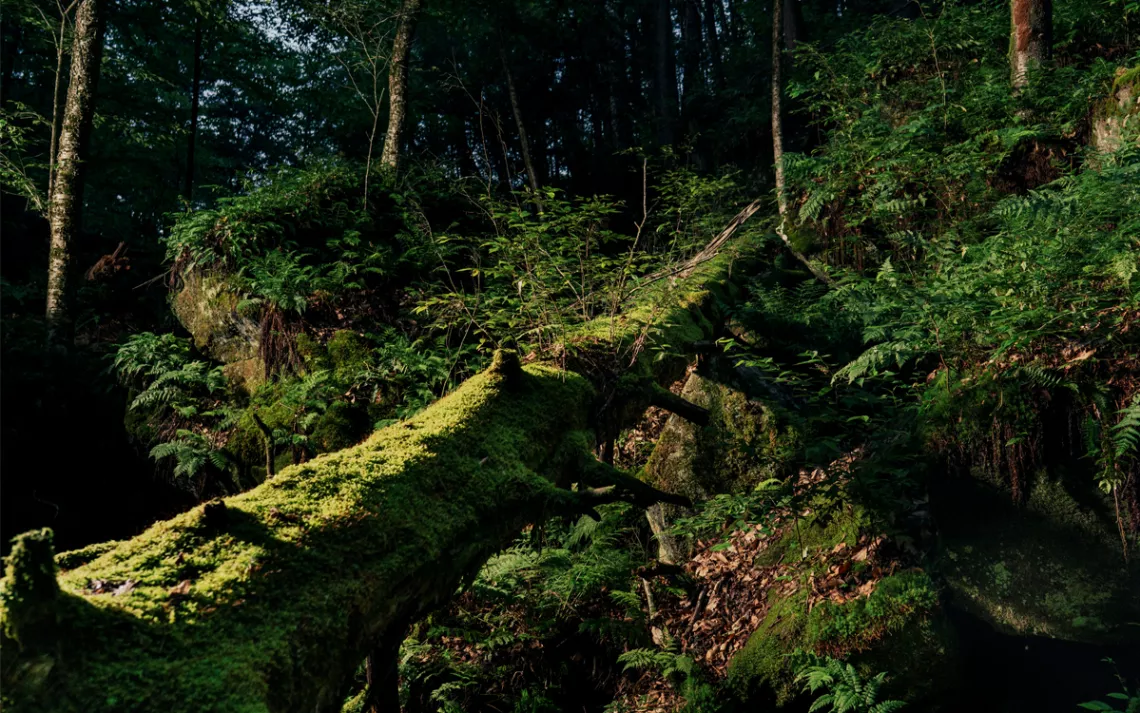
Some old-growth forests stem from fallen trees like this one in Stockbridge. | Photo by David Degner
The first thing I noticed was what was absent. Gone were the choking vines, the creep of poison ivy, the clawing branches. Gone was the claustrophobic competition for light and space. Instead, the forest floor was as open as a park, threaded by wandering streams. It was so thoroughly shaded that the only under-story plants were delicate ferns, lady’s slipper orchids, and trillium. Mosses smothered tree trunks. Lichens clung to boulders. Although I couldn’t immediately put my finger on what it was, something felt different. This is how many people describe their first encounter with northeastern old growth: an intangible sensation that precedes any quantifiable observation. They simply feel that they’re in the presence of something ancient.
That summer, New England had been experiencing crippling heat and drought. Rivers had shrunk to tepid streams, reservoirs had dwindled, and farmers’ crops had withered. Emergency limits on municipal water use had left many lawns brown and brittle. And yet here, water seemed to spring from every imaginable surface, pooling in shady chasms, rushing down in waterfalls, and nourishing fountains of ferns. The forest was so green, it looked nearly tropical, except for a primordial coolness that the afternoon heat couldn’t dispel.
Forests have a cooling effect on both their immediate surroundings and the global climate. Studies show that although younger forests sequester atmospheric carbon dioxide more quickly than mature forests, old-growth forests store more carbon overall than younger forests do. Because of this, old growth plays an important role in scientific models that use trees’ biomass to quantify how much carbon the world’s forests store.
Many such models rely on large-scale data from young, temperate forests made up of relatively small trees. As forests are allowed to mature—and as people like Danielson, the big-tree hunter, find more old growth—it could mean that the computerized models don’t accurately reflect what’s happening on the ground. Already, new studies have shown that actual biomass and carbon storage of forests can be much higher than what models predict; some models have been proved to be off by as much as 70 percent. “That has big implications,” Danielson said. “And we wouldn’t have all those measurements if it weren’t for a lot of these informal researchers going out and measuring trees.”

When trees are allowed to die naturally and crumble into dirt, they support unique webs of fungi that partner with insects, invertebrates, and plants. | Photo by David Degner
In addition to ground-truthing carbon storage models, people are discovering that some tree species in the Northeast can live much longer—and get much bigger—than some scientists recently believed. In the late 1970s, for instance, foresters thought that eastern hemlock could live to a maximum of around 550 years, because that was the age of the oldest known hemlock. Then, in 2023, Danielson found a huge hemlock in northwest Pennsylvania; tree coring proved it to be at least 650 years old. (It could actually be up to 800 years old. The base of this hemlock’s trunk, where the oldest growth rings normally are, is hollow, leaving experts to estimate.) The maximum known ages of many other tree species have similarly increased.
“There’s a lot to learn even with the best-studied tree species,” said Neil Pederson, an ecologist with Harvard Forest. “And old-growth forests are a great place to learn.”
For all that old growth can teach us, though, we still live in a landscape battered by centuries of colonialism. Some tree species, like the American chestnut, have been wiped out by blight. Predators such as mountain lions and wolves that once shaped ecosystems with their appetites have been largely missing from northeastern habitats for centuries, and the salmon that once brought nutrients into the forest are mostly absent too, their migratory routes blocked by dams and development. The traditional ecological practices of Indigenous people who tended to northeastern forests are also heavily suppressed. The old growth we have left, therefore, is far from whole. Many scientists told me that we’re just beginning to scratch the surface of understanding how northeastern forests function in the absence of logging or intensive management.
Other basic information about northeastern old growth is likewise underdocumented. When I asked Joan Maloof, founder of the Old-Growth Forest Network, what percentage of northeastern old growth is permanently protected, and what percentage is found on private lands, she hesitated.
“People tend to assume that we have some sort of [map] that would show where the old growth is,” Maloof told me. “We don’t have that. Nobody has that. Here we are in 2024, and we still don’t know exactly where our remaining old-growth forests are.”
IF CONSERVATIONISTS’ end goal is a corridor of mature forest, finding and documenting the existing old growth is the first step toward getting there. Protecting it is the second. “You’d think old growth would be automatically protected, but that’s not so, not even in the East, where it’s scarce,” said John Davis, who works for both the regional Adirondack Council and the national Rewilding Institute. In the 1990s, Davis’s late mother, Mary Byrd Davis, cataloged all the northeastern old growth known at that time, and he said that some of the sites have since been lost to logging and development.
“Most privately owned old growth is in the hands of conservation-minded families or businesses. Otherwise it probably would be logged by now,” Davis told me. “But you cannot assume that goodwill will always prevail.”
After a patch of old growth is granted permanent protection, the next step is to protect the forest around it so that it can spread. This may already be happening in the Adirondacks. When New York State created its two largest parks—Catskill and Adirondack—nearly 150 years ago, it banned logging and development on all state-owned lands throughout the parks’ combined 6 million acres, stipulating that they would be “forever kept as wild forest lands.” That means the 550 acres of white pines surrounding Bigfoot and the additional 75,000 acres of old growth in the Catskills and Adirondacks are safe from logging. So is the forest around them.
Connecting those protected lands is the last step. In one of many such examples, Davis’s organization and others are working with local land trusts to secure and protect land linking the Adirondacks with Canada’s Algonquin Provincial Park.
Although all these efforts are piecemeal, and different places are at different stages of the process, the overall regional thrust is proceeding in the same direction. We’ve long known that the forests razed and transformed by European colonists have the ability to recover if we let them. But only now—for perhaps the first time since colonization—does it feel as though a critical mass of individuals, governments, and organizations have the willpower, tools, and knowledge to support such recovery.
As I reported this story and talked with passionate people dedicating their lives and careers to this cause, I began to suspect that the Northeast is on the verge of a vast rewilding. It may not happen in my lifetime, or even my daughter’s, but on their own incomprehensibly slow timescales, the forests will recover.
As millions of tons of leaves fall from the trees each autumn and settle onto the ground, the forests will heal. As the leaf litter turns into duff, and the duff into humus and the humus into soil, growing a millimeter deeper at a time, they’ll heal. As decomposer organisms crawl and fungal roots silently squirm through the soil, they’ll heal. More and more forests will eventually come to look like the horizontal old growth of Pisgah State Park, or the towering white pines of the Adirondacks, or the decadent emerald woods of Mohawk Trail. As John Davis put it: “I believe in the concept of future old growth.”
This article has been updated since publication.
 The Magazine of The Sierra Club
The Magazine of The Sierra Club

